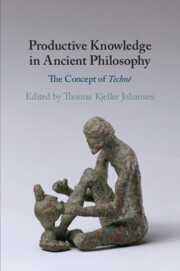Book contents
- Productive Knowledge in Ancient Philosophy
- Productive Knowledge in Ancient Philosophy
- Copyright page
- Contents
- Contributors
- Acknowledgements
- List of Abbreviations
- Introduction
- Chapter 1 Protagoras on Political Technê
- Chapter 2 Dynamic Modalities and Teleological Agency
- Chapter 3 Technê As a Model for Virtue in Plato
- Chapter 4 Crafting the Cosmos
- Chapter 5 Aristotle on Productive Understanding and Completeness
- Chapter 6 Technê and Empeiria
- Chapter 7 The Stoics on Technê and the Technai
- Chapter 8 The Epicureans on Technê and the Technai
- Chapter 9 The Sceptic’s Art
- Chapter 10 Plotinus on the Arts
- Chapter 11 Productive Knowledge in Proclus
- Bibliography
- General Index
- Index Locorum
Chapter 10 - Plotinus on the Arts
Published online by Cambridge University Press: 14 January 2021
- Productive Knowledge in Ancient Philosophy
- Productive Knowledge in Ancient Philosophy
- Copyright page
- Contents
- Contributors
- Acknowledgements
- List of Abbreviations
- Introduction
- Chapter 1 Protagoras on Political Technê
- Chapter 2 Dynamic Modalities and Teleological Agency
- Chapter 3 Technê As a Model for Virtue in Plato
- Chapter 4 Crafting the Cosmos
- Chapter 5 Aristotle on Productive Understanding and Completeness
- Chapter 6 Technê and Empeiria
- Chapter 7 The Stoics on Technê and the Technai
- Chapter 8 The Epicureans on Technê and the Technai
- Chapter 9 The Sceptic’s Art
- Chapter 10 Plotinus on the Arts
- Chapter 11 Productive Knowledge in Proclus
- Bibliography
- General Index
- Index Locorum
Summary
In the early treatise Ennead V.9, Plotinus discusses whether the arts are there in the intelligible realm, and concludes that they are at least partly. The chapter’s first part discusses a number of questions that arise. What is exactly the principle of division for which arts or which parts of an art are in the intelligible realm? What is the status of the arts in the intelligible world? Are there Platonic Forms of the arts? In a later treatise, V.8., Plotinus argues that rather than imitating sensible objects, some artists concerned with producing beautiful sensible objects imitate the intelligible paradigm of beauty. Emilsson discusses this claim, which seems a clear deviation from the account of mimetic art in Plato’s Republic. In the latter half of the chapter, Emilsson addresses Plotinus’ demythologisation of Plato’s Timaeus. Plotinus replaces the Demiurge of the Timaeus with the universal intellect and the World-Soul, which do not deliberate. However, Plotinus does not reject entirely any craftsman model, for he appeals to performance arts, which do not involve deliberation, in explaining how natural processes flow from higher principles. Emilsson then discusses what sort of conception of the arts lies behind this view.
- Type
- Chapter
- Information
- Productive Knowledge in Ancient PhilosophyThe Concept of <I>Technê</I>, pp. 245 - 262Publisher: Cambridge University PressPrint publication year: 2021



